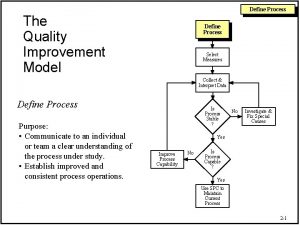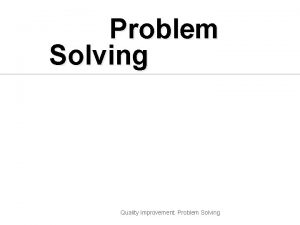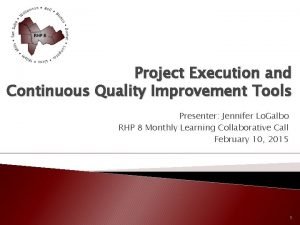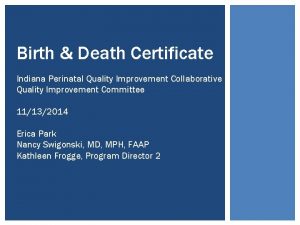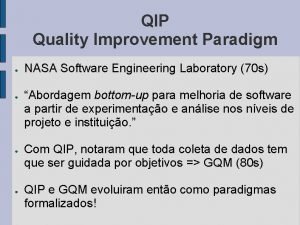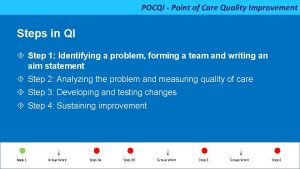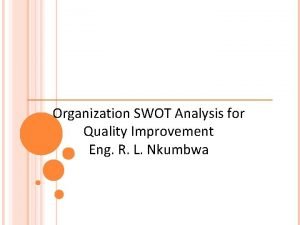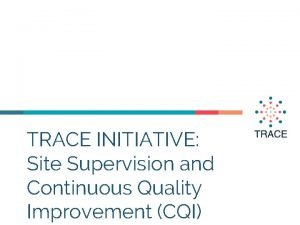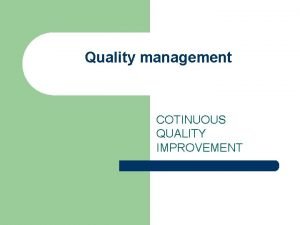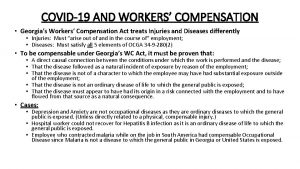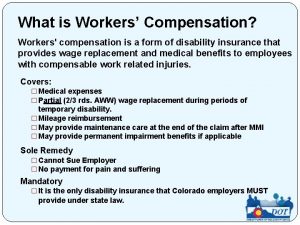Quality Improvement Lessons for Workers Compensation Quality of



























- Slides: 27

Quality Improvement: Lessons for Workers’ Compensation Quality of Care Linda Rudolph, MD, MPH Medi-Cal Managed Care Division CA Department of Health Services May 1, 2003

What Do We Want? Quality • “The degree to which health services for individuals and populations increase the likelihood of desired patient outcomes given the current state of knowledge” IOM, 1990 • The extent to which health services meet their aim – improving health.

What Do We Want? (DWC Focus Groups) • • • accessible competent state of the art caring trusting • • • patient-oriented patient-selected reasonably priced coordinated continuous DWC, Improving the QOC for Injured Workers, 2001

What Do We Want? (Institute of Medicine) • Safe • Effective • Efficient • Timely • Patient Centered • Equitable IOM, Crossing the Quality Chasm, 2001

What Do We Have?

What Do We Have? • • Distrust Poor access to specialists Delays in care Fragmentation and lack of continuity Care not patient-centered Inefficient and ineffective care No accountability Improving the Quality of Care for Injured Workers: Focus Group Discussions. DWC. 2001

“Every system is perfectly designed to produce the results that it does achieve. ” (Berwick/Batalden)

What can we do? • Accountability • Improvement

Accountability • • Policies and contracts Monitoring Measurement Reporting

You can’t fatten a calf by weighing it…. Palestinian proverb

Improvement A systematic program for taking a system from one level of performance to a higher level of performance

Low Back Pain • ¼ w. c. claims • 1/3 w. c. costs

What Do We Have? • Care highly variable • Care inconsistent with guidelines • Patient outcomes poor

Theory of Change • Will • Ideas • Execution/supporting change

Low Back Pain = Chronic Illness

Care Model for Worker Health (adapted from IHI/Dr. Ed Wagoner)

Resources and Policies • Resources to support injured workers and providers are easily accessible • Insurers, State agencies, employers, and health care providers: – coordinate and partner with each other around worker and injured worker needs – promote and offer evidence-based effective interventions and programs • System incentives are aligned for policy (adapted from Institute for Healthcare Improvement’s Breakthrough Series Collaborative: Improving Care for People with Chronic Conditions. E Wagoner, and NICHQ)

Health and W. C. System • Specific goals for prevention and care management are part of the strategic and business plan. • Senior leadership is committed to meeting the needs of injured workers. Encourage coordination among primary care and occupational medicine care • System has adopted an effective performance improvement model. • Incentives support these organizational goals. (adapted from Institute for Healthcare Improvement’s Breakthrough Series Collaborative: Improving Care for People with Chronic Conditions. E Wagoner, and NICHQ)

Self-Management Support • Emphasize worker’s active and central role in managing illness • Resources available to increase patient knowledge, confidence, and skills • Workers assisted in setting shared goals • Workers have access to peer support • Workers assisted in improving communication with providers about health care. (adapted from Institute for Healthcare Improvement’s Breakthrough Series Collaborative: Improving Care for People with Chronic Conditions. E Wagoner, and NICHQ)

Decision Support • Evidence-based guidelines and protocols integrated into practice systems • Integrated expertise (occ med, specialists, mental health, w. c. , workplace) • Care team works to maximize cooperation, continuity, and patient outcomes • Use of modalities proven to change practice behavior (adapted from Institute for Healthcare Improvement’s Breakthrough Series Collaborative: Improving Care for People with Chronic Conditions. E Wagoner, and NICHQ)

Delivery System Design • Practice anticipates problems, provides services to maintain QOL and function • Roles/responsibilities of team members defined, appropriate training provided • Systems designed for regular communication and f/u (adapted from Institute for Healthcare Improvement’s Breakthrough Series Collaborative: Improving Care for People with Chronic Conditions. E Wagoner, and NICHQ)

Clinical Information System • Registry of patients in need of services maintained • Reminder system used for patients and care team • Information system provides regular feedback to care team • System allows for care planning (adapted from Institute for Healthcare Improvement’s Breakthrough Series Collaborative: Improving Care for People with Chronic Conditions. E Wagoner, and NICHQ)

Model for Improvement

Aims • • Reduce plain x-rays Reduce opiate prescriptions Increase patient self-management education Increase availability of modified work

From Aim to Improvement • • Define measures (process, outcome) Barrier analysis Identify available interventions Identify target population Outreach Implement interventions: Did it work? Start again!

Quality Improvement Collaboratives • • • Medi-Care Medi-Cal Pursuing Perfection/Rewarding Results CPCA (HRSA) DHS CCHRI

 Oregon workers compensation division
Oregon workers compensation division Preventing cuts
Preventing cuts Maine workers compensation forms
Maine workers compensation forms Maine workers compensation forms
Maine workers compensation forms Controlling workers compensation costs
Controlling workers compensation costs Workers compensation fraud detection
Workers compensation fraud detection Texas hcn workers compensation
Texas hcn workers compensation Montana workers compensation court
Montana workers compensation court Compensation and non compensation dimensions
Compensation and non compensation dimensions Define quality assurance in nursing
Define quality assurance in nursing Quality improvement vs quality assurance
Quality improvement vs quality assurance Quality counts background checks
Quality counts background checks Quality improvement
Quality improvement Efmd quality improvement system
Efmd quality improvement system Quality improvement
Quality improvement Crosby's fourteen steps to quality improvement
Crosby's fourteen steps to quality improvement Xerox problem solving process
Xerox problem solving process Qsen definition
Qsen definition Continuous quality improvement plan example
Continuous quality improvement plan example Juran 10 steps to quality improvement
Juran 10 steps to quality improvement Indiana perinatal quality improvement collaborative
Indiana perinatal quality improvement collaborative Quality improvement paradigm
Quality improvement paradigm Sus qi
Sus qi Pocqi ppt
Pocqi ppt Data driven quality improvement
Data driven quality improvement Swot analysis for quality
Swot analysis for quality Continuous quality improvement program planning worksheet
Continuous quality improvement program planning worksheet Cotinuous
Cotinuous














